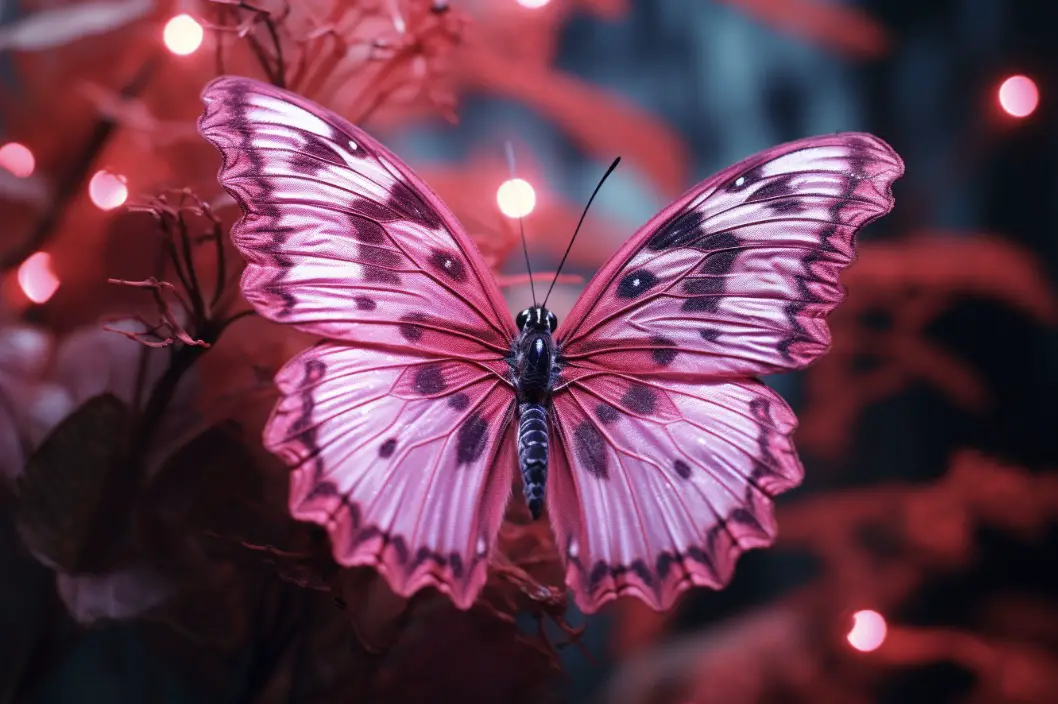Pink butterflies have been a topic of discussion for a long time. In this article, we will explore the existence of these insects and delve deeper into their characteristics.
Several subspecies of butterflies such as the Rust-coloured Swallowtail, Purple Emperor, and Red Lacewing possess pinkish markings.
Nevertheless, these are not true pink butterflies. In this article, we will unravel the mystery behind the rarest colour of these species, discuss the factors that affect their wingspan, and look into the impact of deforestation and climate change on their habitat.
Additionally, we will also explore the illegal trade of these insects and the consequences of habitat destruction. Join us on this journey to discover if pink butterflies truly exist and what we can do to preserve their home.
Contents
Key Takeaway:
- Pink butterflies may exist, but they are extremely rare: While no known species of butterfly is entirely pink, some species have pink markings or hues on their wings. These sightings are rare and should be cherished if encountered.
- Butterflies come in a variety of colors: From the vibrant blue morpho to the subtle Palos Verdes blue, butterflies exhibit a wide range of colors and patterns. However, populations of many species are declining due to habitat destruction and other factors.
- It is important to protect butterfly populations and their habitats: Butterflies play an important role in pollination and are crucial to the health of ecosystems. Conserving their habitats and minimizing human impact on their populations is essential for their survival.
Curious if pink butterflies exist? You’ve come to the right spot. We’ll check if they exist in the wild. And dive deep into their importance to nature and why they matter.
Pink Butterflies – Do They Reallt Exist?
Pink Butterflies – Is their Existence Real or a Myth?
The existence of pink butterflies has been long-debated amongst butterfly enthusiasts and researchers. While some claim to have seen them, others dispute their existence.
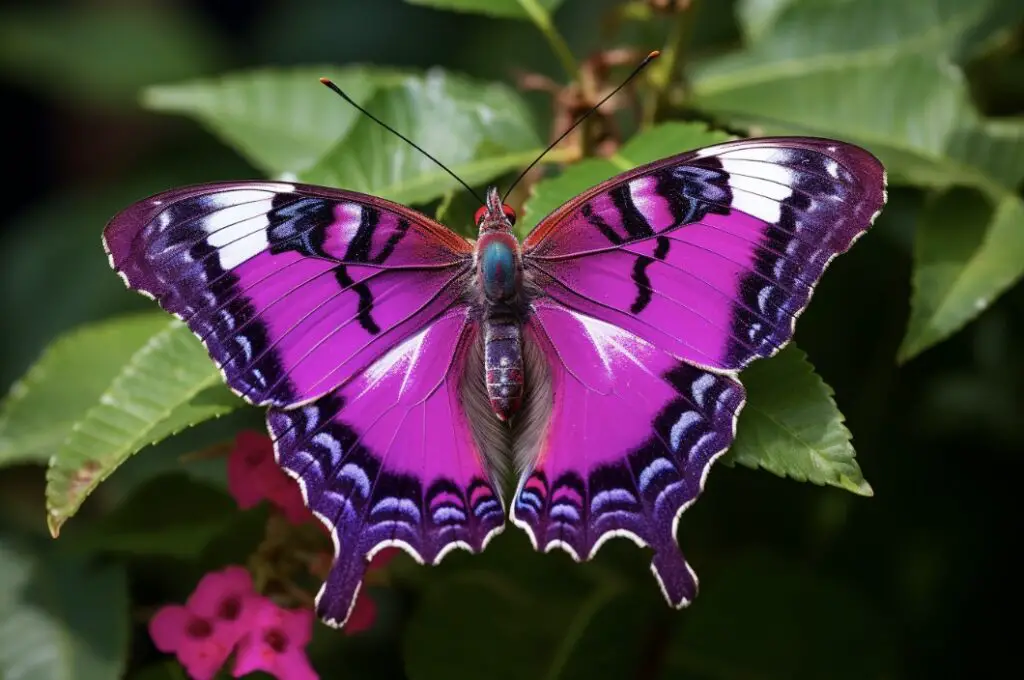
These unique creatures can be found in varying shades of pink, ranging from pale pastels to vibrant fuchsias. Some species even have a blue shimmer or sapphire dots on their wings, making them one of the rarest butterflies in the world.
Researchers have reported sightings of pink butterflies in several regions like San Juan Islands, Southern Florida, Eastern Himalayan Mountains, Papua New Guinea, and Palos Verdes Peninsula. However, as these species are endangered and facing habitat collapse due to climate change and human activity, it is becoming increasingly difficult to spot them.
If you’re an avid collector or simply appreciate nature’s beauty, don’t miss out on the opportunity to witness these stunning oval-shaped insects with creamy off-white bodies and rainbow-like colored wings before they disappear forever.
The Rarest Coloured Butterflies
Butterflies are renowned for their striking and vibrant colors, with some hues being rarer than others. Their multi-colored wings can range from pale pastels to bright and bold shades. Exploring the world of these beautiful insects, we uncover some of the rarest colored butterflies.
Among the rarest colored butterflies are the electric blue Morpho butterfly, the bright orange Julia butterfly, the metallic green Kaiser-I-Hind butterfly, and the deep black Swallowtail butterfly.
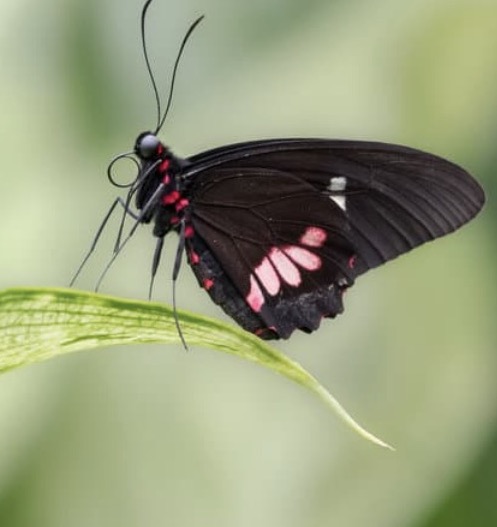
Others include the Pink-spotted Cattleheart and the Red-bodied Swallowtail, which are notable for their unique traits and are highly sought after by collectors.
- Electric blue Morpho butterfly
- Bright orange Julia butterfly
- Metallic green Kaiser-I-Hind butterfly
- Deep black Swallowtail butterfly
- Pink-spotted Cattleheart butterfly
- Red-bodied Swallowtail butterfly
The rarest colored butterflies are not just limited to their wings but can also be found in the patterns and shapes of their bodies.
They can have intricate and unusual details, such as the zebra-like stripes of the Zebra Swallowtail and the striking geometric patterns of the Purple-spotted Swallowtail.
The Ruby (or Red-Bodied) Swallowtail
The Ruby Swallowtail (Papilio ophidicephalus) is a species of swallowtail butterfly known for its striking and vibrant colors. The name “Ruby Swallowtail” is derived from the rich ruby-red hues present on its wings. However, the appearance of these butterflies can vary due to factors such as fading, lighting conditions, or genetic variations.
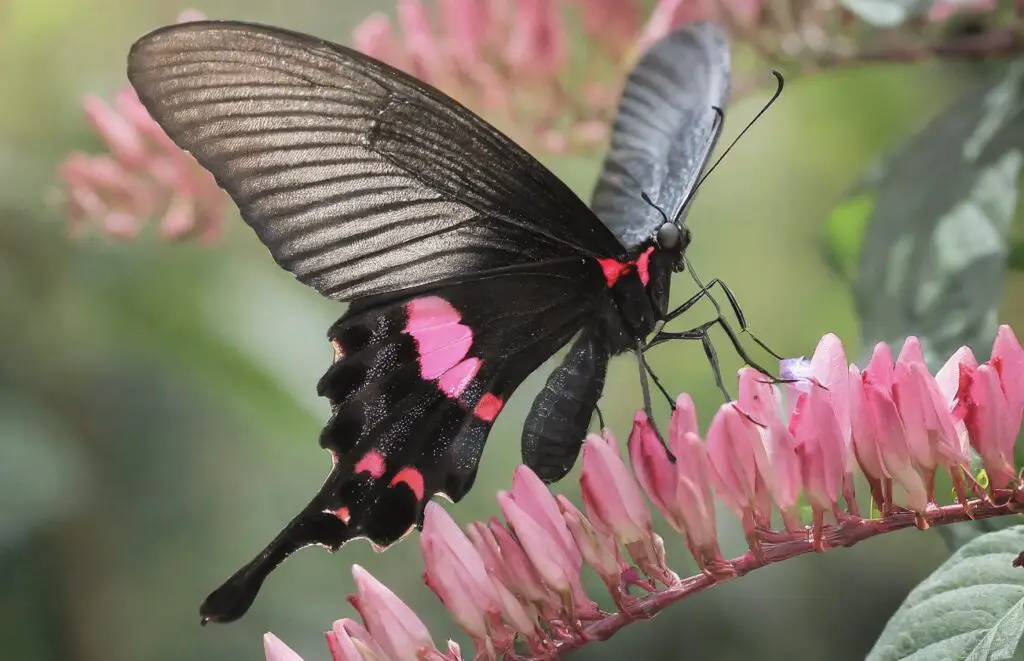
In their pristine state, Ruby Swallowtails exhibit a combination of iridescent ruby-red and black on their wings. The red coloration is often a result of microscopic structures on the wing scales that refract light, creating a dazzling display. These butterflies are also characterized by intricate patterns and markings, adding to their overall beauty.
Under certain circumstances, the red coloration of Ruby Swallowtails may appear pink. This can happen due to several reasons:
- Fading: Exposure to sunlight and environmental conditions can cause the pigments in the wings to fade over time. As a result, the intense ruby-red color may lose some of its vibrancy and shift towards a lighter, pinkish tone.
- Lighting Conditions: The color perception of the Ruby Swallowtail can be influenced by the angle and intensity of light. In certain lighting conditions, especially when sunlight is diffused or filtered through foliage, the red hues may appear more subdued and take on a pinkish tint.
- Genetic Variants: Some individuals within the Ruby Swallowtail population may carry genetic variations that affect the expression of pigments or the structure of wing scales. These variations can lead to a range of colorations, including shades of pink.
The ability of the Ruby Swallowtail to exhibit pinkish hues adds an extra layer of intrigue to its already captivating appearance. These butterflies are not only a visual delight but also serve as fascinating examples of how environmental and genetic factors can influence the colors observed in nature.

These rare butterflies are not only beautiful but also play a crucial role in the ecosystem as they help pollinate plants.
Pro Tip: To observe these rare and stunning butterflies in their natural habitat, visit butterfly gardens or natural parks that offer butterfly exhibits and educational programs. Remember to respect their environment and avoid disturbing them.
Blue Morpho
The Blue Morpho is a stunning butterfly found in Central and South America. It’s known for its striking blue iridescence, which is actually an optical illusion created by the microscopic scales on its wings. These butterflies have wingspans that can reach up to 8 inches and are named after the Greek god of transformation due to their impressive metamorphosis from caterpillars to adults.
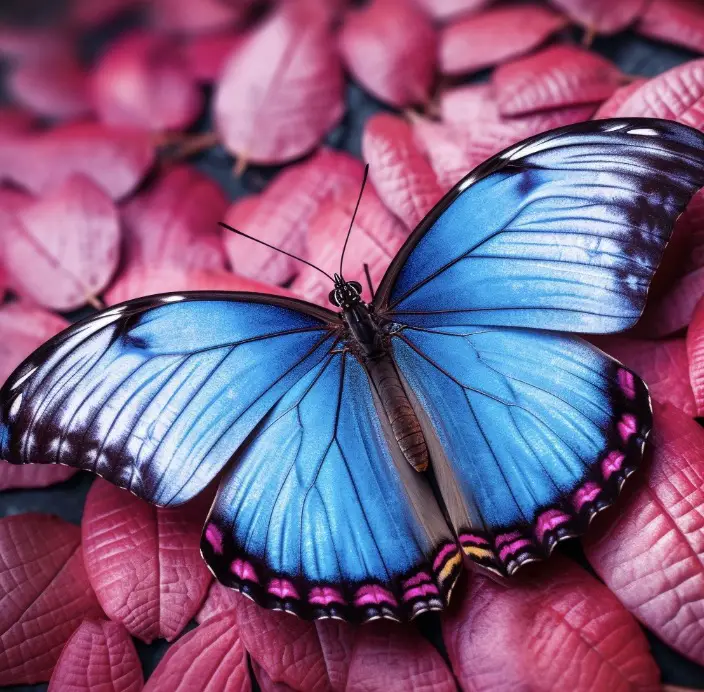
The Blue Morpho has been a source of fascination for scientists and nature enthusiasts alike, as their wings appear to change color depending on the angle they’re viewed from. This effect is caused by the way light reflects off of the scales on their wings, creating a shimmering, almost metallic appearance.
What many people don’t know about Blue Morphos is that they also have other colors and patterns on their wings besides blue. While not as common or iconic as their blue hue, some Blue Morphos have brown or yellow markings on their wings, and even small splashes of pink or purple. These rare colors and patterns make them even more sought-after by collectors and researchers.
A unique trait of this butterfly is how it’s perceived in different cultures around the world. In some indigenous cultures, it’s believed that the Blue Morpho represents transformation and spiritual growth, while in others it’s seen as a symbol of death or rebirth. Despite these varying interpretations, one thing remains clear: The Blue Morpho is a truly remarkable creature worth admiring.
The Purple Emperor Butterfly: A Glimpse of Pink Amidst Majesty
The Purple Emperor (Apatura iris) butterfly, renowned for its regal appearance and enchanting presence, boasts a captivating blend of colors that can vary with lighting conditions and age. Although its name suggests a monochrome majesty, the Purple Emperor can, under certain circumstances, exhibit a surprising and ephemeral hue of pink, adding a layer of mystique to its already captivating nature.
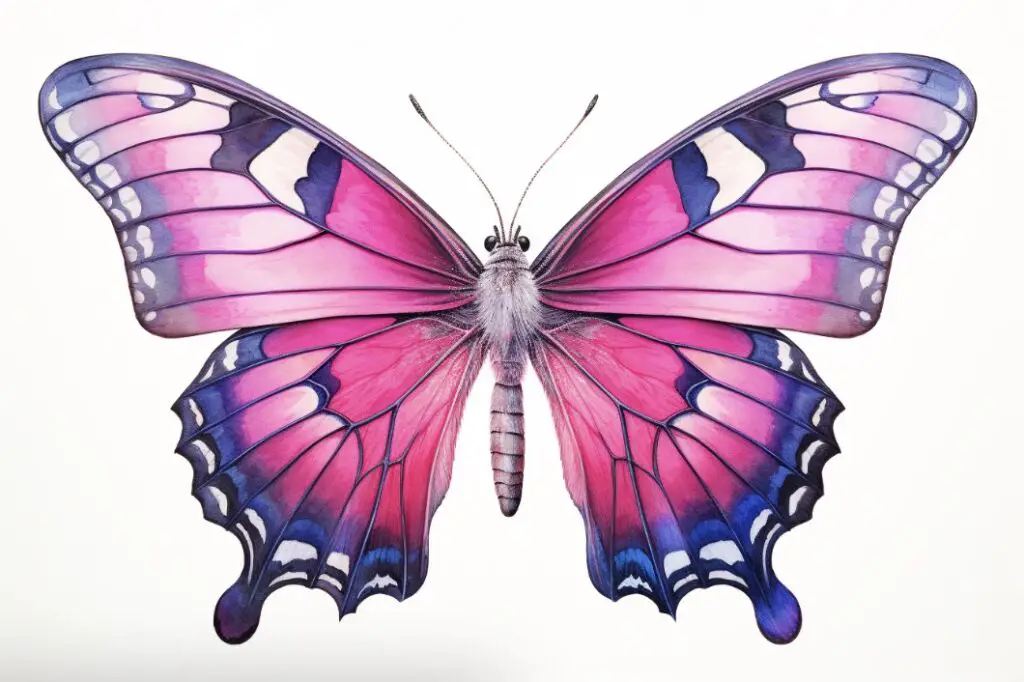
In its prime, the Purple Emperor is predominantly recognized for its iridescent deep purple-black wings, which shimmer in the sunlight like the robes of royalty. Its unique wing structure also contributes to its grandeur, with a wingspan that can reach up to 80 millimeters, making it one of the largest butterfly species in Europe. The males, in particular, are adorned with striking iridescent patches on their wings, reflecting an array of colors when viewed from various angles.
However, it is not uncommon for these butterflies to appear pinkish under specific lighting conditions or when their wings have started to fade due to age or wear. The prismatic nature of their wing scales and the microscopic structures on their wings contribute to this phenomenon. When light interacts with these structures, it can result in the dispersion and reflection of different wavelengths, causing a visual effect akin to seeing the color pink. This occurrence is similar to the way soap bubbles create vibrant hues due to the interference and scattering of light waves.
In some instances, observers might chance upon a Purple Emperor butterfly in the late afternoon or early evening, when the angle of the sun’s rays is lower, creating a softer and warmer light. Under these conditions, the predominantly purple-black wings can take on a rosy tint, as the light’s warmer wavelengths interact with the wing scales. This subtle transformation adds an enchanting twist to the butterfly’s appearance, as if it has momentarily traded its royal purple for a delicate blush.
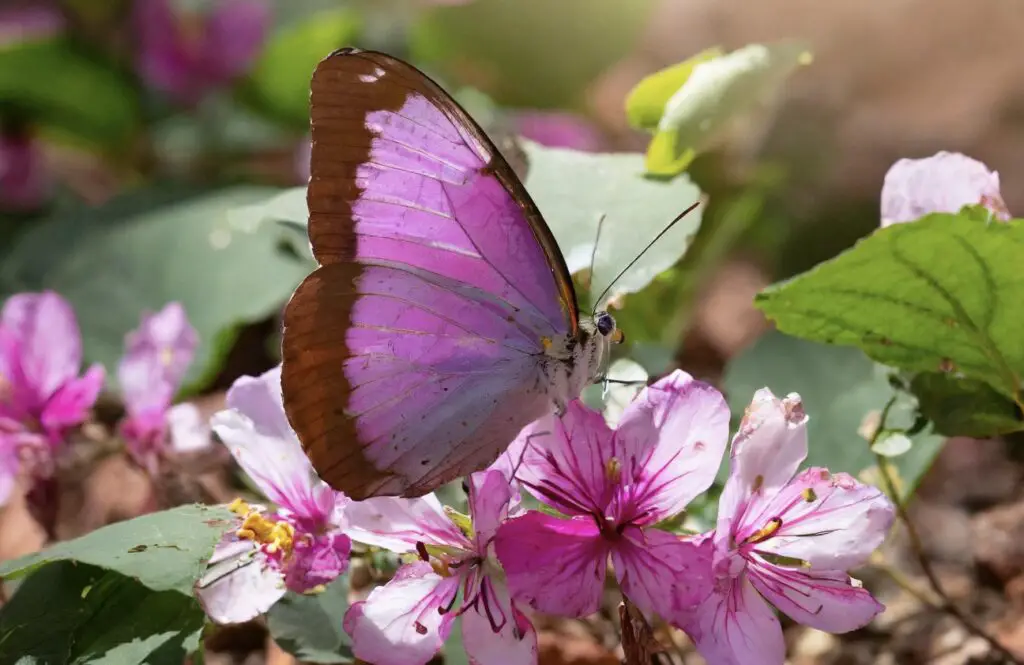
Moreover, the passage of time can also play a role in this intriguing color shift. As the wings of a Purple Emperor butterfly age, the pigments responsible for their deep coloration can degrade, causing the colors to fade. During this process, the iridescence that once showcased shades of purple may take on a softer and more subdued pinkish hue, further accentuating the butterfly’s inherent elegance.
In conclusion, the Purple Emperor butterfly’s ability to appear pink in color, whether due to fading wings or the play of light, adds an extra layer of allure to this already captivating species. Its ephemeral transformation from royal purple to delicate pink serves as a reminder of the beauty and complexity found in the natural world, inviting us to appreciate the intricate interplay between light, color, and the intricate structures of the butterfly’s wings.
Island Marble
Found in the Pacific Northwest, the Island Marble butterfly is a beautiful and rare species. With creamy white wings and intricate marble-like patterns, this butterfly can be difficult to spot due to its dwindling population.
While not usually pink in color, there has been rare incidences of individuals with pink hues.
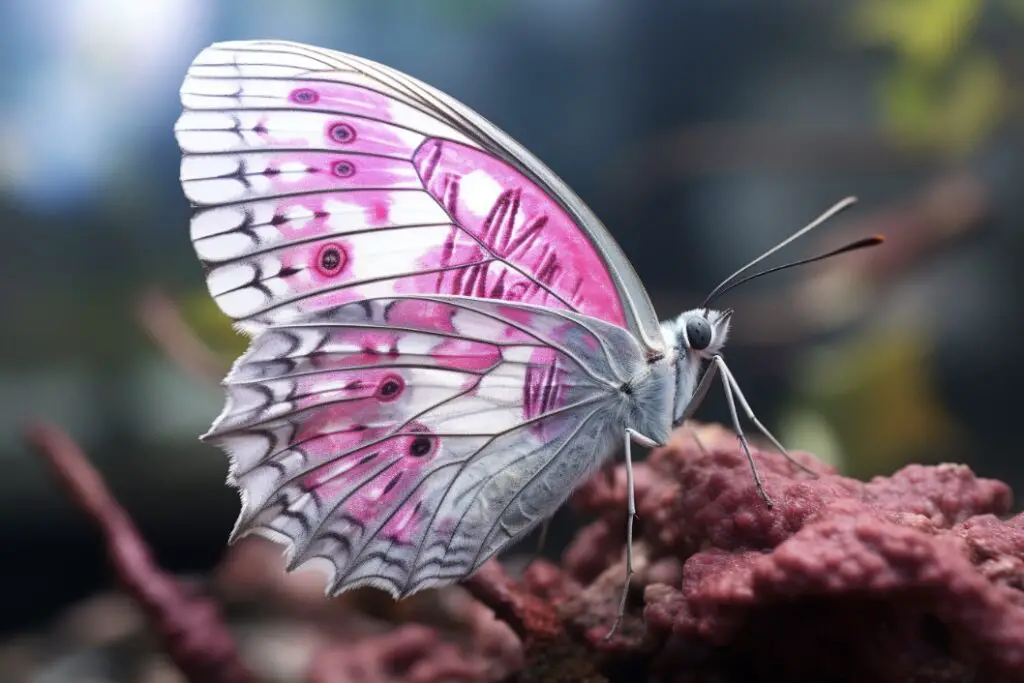
The Island Marble butterfly was first discovered in 1937 and was once quite abundant. However, it has now become endangered due to habitat loss, climate change and other factors. In recent years, conservation efforts have been put in place to protect this delicate species.
Unique to the Island Marble is its preference for nesting on rocky coastlines and wetlands, making it a unique sight for dedicated butterfly enthusiasts.
Interestingly enough, biologists were able to rediscover this elusive species in an unlikely location: Seattle’s Discovery Park. Their discovery resulted in successful breeding programs aimed at increasing their population numbers.
The beauty of the Island Marble reminds us of the importance of protecting our planet’s biodiversity. As humans continue to encroach upon nature’s territories, we must remember our responsibility to ensure that future generations have the opportunity to appreciate such rare wonders of nature.
Schaus Swallowtail
The Schaus Swallowtail butterfly is a rare species found in South Florida, USA. It is listed as critically endangered and protected by federal laws. Below is a table showcasing some of its unique characteristics:
| Characteristics | Details |
|---|---|
| Scientific name | Heraclides aristodemus ponceanus |
| Habitat | Tropical hardwood hammocks |
| Diet | Nectar from various flowers, orange tree sap and rotting fruit |
| Wingspan | Approximately 9-10 cm |
| Appearance | Black with yellow markings on upper wings, blue-green coloration on lower wings with irregularly shaped silver spots |
In addition to its endangered status, the Schaus Swallowtail plays a vital role in its ecosystem as a pollinator. Unfortunately, due to habitat loss and degradation, this butterfly’s population has drastically declined over recent decades. Once thought to be extinct, conservation efforts have helped revive the Schaus Swallowtail population. However, it remains imperative that we continue to protect and preserve these beautiful creatures for future generations.
For example, a community effort in the Florida Keys restored a degraded forest that doubled the size of the butterfly population in only one year. By supporting initiatives such as these, we can work towards ensuring that this delicate species continues to thrive for years to come.
Zebra Longwing
This particular butterfly is known for its black and white striped wings with vibrant yellow hues on the edges. It is commonly referred to as the Equus Heliconian or Heliconius Charithonia. The Zebra Longwing can be found in Southern United States, Central America, and throughout South America, making it a relatively widespread species.
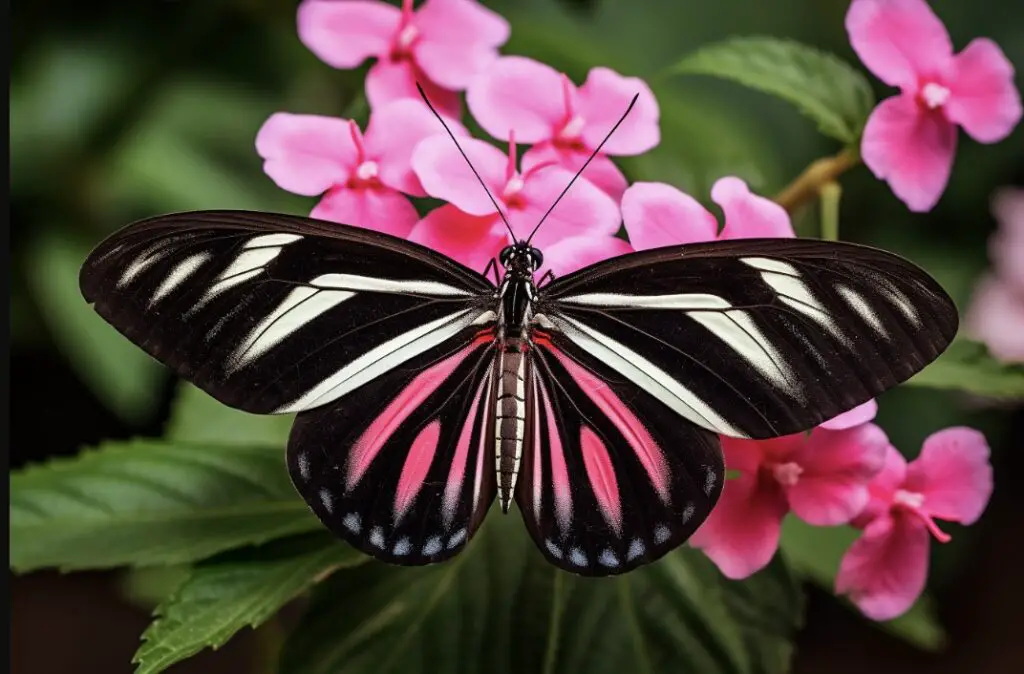
The unique characteristic of this butterfly is its ability to feast on a wide variety of nectar plants as well as pollen. It has been known to focus on one type of plant at a time for a period of five to six days before switching to another species. Additionally, the Zebra Longwing has an exceptional lifespan among butterflies; they can live up to six months as compared to only one week for other common species.
Pro Tip: If you want to attract Zebra Longwings into your garden or yard, consider planting passionflowers – their favorite food source!
Chimaera Birdwing
The Chimaera Birdwing is a one-of-a-kind and intriguing butterfly species, known for its unique features. It is a large insect with a wingspan of up to 17 cm, and its particularity lies in the fact that it is a hybrid between two different butterflies.

The Chimaera Birdwing displays striking colors, with bright yellow wings that have black stripes, veins, and borders. This butterfly can be found in the wild only in certain areas of Indonesia, making it an exclusive sighting for fortunate observers.
Below is a table providing additional information on the Chimaera Birdwing.
| Characteristic | Description |
|---|---|
| Wingspan | Up to 17 cm |
| Colors | Bright yellow wings with black stripes |
| Habitat | Indonesia |
| Population status | Endangered |
Despite being widely admired by entomologists and collectors alike, these beautiful creatures are endangered due to deforestation and poaching. Despite conservation efforts focusing on protecting their natural habitat and regulating trapping, their population continues to decrease. Observing them up close is a rare occurrence that demands attention and caution.
To appreciate the significance of this species’ survival struggle, one must recognize that our planet’s biodiversity represents countless forms of life interrelated in complex ecosystems. A world without these beings would be infinitely poorer in beauty as well as function. We must do everything we can to ensure the survival of such extraordinary animals as the Chimaera Birdwing.
Bhutan Glory
The Bhutan Glory is a rare species of butterfly found in the eastern Himalayas. It has a vibrant blue color with black and white stripes on its wingspan of about 3 inches. The female of this species has a dull brown tint and is relatively smaller than the male counterpart. The Bhutan Glory is known for its unique zigzag flight pattern and mostly feeds on nectar from flowers like Primula denticulata, Rhododendron, and Lonicera species.
If you plan to see this rare butterfly species in person, you may want to visit eastern Himalayas between May to July or September to November as these are the breeding months for Bhutan Glory butterflies. You need to trek through dense forests that suit their habitat, which can be challenging even for experienced trekkers.
To improve your chances of spotting these butterflies, consider hiring an expert tour guide who knows the region’s geography and wildlife well. They can help identify spots where these butterflies are commonly seen, depending on the weather conditions, time of day, and season.
In addition, carry high-quality binoculars or a camera with a telephoto lens that gives a clear view from a distance without disturbing their natural habitat. Wear clothing that blends with nature’s color scheme so that it does not alarm or scare them away.
Queen Alexandras Birdwing
The Queen of the birdwings, an endangered species with a wingspan of up to a foot and an elegant black body, is one of the largest butterflies in the world.
Native to Papua New Guinea’s forests, it feeds on certain flowering trees and shrubs. The female’s vivid colours are less striking than the male’s iridescent blue-green forewings.
In addition to its stunning appearance, this butterfly has gained attention due to its rarity and conservation status. It is heavily impacted by habitat loss and illegal trade but has benefitted from captive breeding programs.
A unique adaptation is the birdwing’s ability to navigate dense forest canopies via large wings that support their sizeable weight while also allowing for manoeuvrability.
Pro Tip: To ensure continued survival of this beautiful creature, sources claim to only purchase butterfly specimens from reputable sources or avoid purchase altogether.
Miami Blue
This shade of blue was once seen as a staple of the Floridian ecosystem, but due to habitat loss and over-collection, it’s now considered critically endangered. Miami Blue is a species of butterfly that is endemic to southern Florida. Its striking blue wings are highlighted by black borders.
Miami Blue is unique in that it has a very limited distribution range and experiences highly localized environmental pressures. In addition, its existence is threatened by human activity such as development and the illegal pet trade. Conservation efforts are being made to protect habitats and reintroduce captive-bred butterflies into the wild.
Protecting Miami Blue from extinction requires not only active conservation efforts but also public awareness and support. As responsible global citizens, we must take it upon ourselves to help prevent the irreversible loss of this beautiful creature. The fear of missing out on witnessing one of nature’s most spectacular wonders should motivate us to take action towards its preservation.
Palos Verdes Blue
The Palos Verdes Blue is a rare butterfly species endemic to the Palos Verdes Peninsula in California. It is classified as an endangered species due to habitat loss.
Below is a table providing factual information about the Palos Verdes Blue butterfly:
| Fact | Data |
|---|---|
| Scientific name | Glaucopsyche lygdamus palosverdesensis |
| Habitat | Coastal sage scrub vegetation |
| Lifespan | One week |
| Food source for caterpillars | Deerweed |
It’s worth noting that there are only around 200 individuals of this species left in the wild.
Interestingly, a landmark case known as the “Palos Verdes Blue” case helped establish greater protections for endangered species under the Endangered Species Act.
Our 14 Fun Facts About Butterflies
Butterflies are fascinating creatures that come in various shapes, sizes, and colors. Here are some interesting details about these insects:
- They taste with their feet! Butterflies use special sensors on their legs to locate food sources.
- Their wings are covered in tiny scales that give them their colorful patterns.
- The world’s smallest butterfly is the Western Pygmy Blue, which only measures half an inch.
- Butterflies can see ultraviolet light and use this talent to communicate with each other, find mates, and search for food.
- Some butterflies can migrate up to 3000 miles during their lifetime!
- Butterfly chrysalises can be camouflaged to match their surroundings, making it harder for predators to find them.
Did you know that some species of butterflies have a lifespan of less than a week? In contrast, others may live up to several months or even years. Despite their delicate appearance, butterflies are incredibly resilient and adapt well to changing environments.
A popular myth about butterflies is that they symbolize rebirth or resurrection because of the way they transform from a caterpillar into a butterfly. The ancient Greeks thought this transformation represented the soul’s journey from one realm to another. However, historically, butterflies were also used as symbols of love and beauty in ancient Chinese and Japanese cultures.
Causes of Butterfly Population Collapse
Butterfly Population Decline: What Soars the Drastic Decline?
Butterflies are an essential part of Earth’s ecological system and serve as a crucial pollinator in maintaining the balance of nature. However, the escalation in human activities such as deforestation, land development, and pesticide utilization has instigated a significant reduction in the butterfly population. These factors have caused inadequate habitat and food for butterflies, leading to a decline in their numbers.
The loss of natural habitat due to human activities has been the predominant reason for the decrease in butterfly populations. Furthermore, the loss of host plants that cater to the larvae of several butterfly species has become a major concern. Urbanization has also led to the removal of native plant species, leading to a reduction in the plant diversity. Additionally, the extensive usage of pesticides has contaminated the nectar and pollen present in flowers, ultimately affecting the reproduction process.
The butterfly population decline has inflicted dire consequences on the ecological system. These insects are an integral part of the food chain, primarily serving as a food source for birds, lizards, and other species. The ecological ramifications of the decline have become a growing concern for environmentalists and conservationists globally.
While the butterfly population has suffered a massive decline recently, historical recordings have evidence of occurrences like this in the past. For instance, the California Pipevine Swallowtail faced near-extinction in the 20th century, but conservation efforts have led to its revival.
Habitat Destruction
The decline in natural habitats, brought about by human activities, has inflicted significant damage to the ecosystem. The destruction of ecosystems leads to habitat loss, causing a drop in butterfly populations. Deforestation is one of the biggest contributors, resulting in habitat fragmentation and migration of habitats towards human settlements.
Expanding urbanization is a crucial cause as well. The unprecedented development of infrastructure causes the population to move towards urban areas. Urbanization destroys green spaces that serve as vital butterfly habitats. Moreover, increasing pollution from factories and vehicles can impact the butterfly’s life cycle and population growth rates.
It is also worth noting that habitat destruction greatly affects this delicate creature’s breeding grounds and food sources. Butterflies rely on native plants for sustenance and reproduction, so any alteration in natural habitats due to deforestation or other anthropogenic factors will intentionally reduce their population size.
A study by O’Brien et al., published in PLOS ONE journal, indicates that “habitat loss is happening at an unprecedented rate,” which will leave future generations with a much depauperate natural world”.
Short Lifespan of Adults
Adults’ Lifespan is Noteworthy in Health and Medicines
Human beings have a limited lifespan that varies according to several factors. The length of adult’s lives is crucially significant, especially in the healthcare industry, where it plays a pivotal role in researching and developing medicines. Research proves that adults’ lifespan has been expeditiously declining over time.
Consequently, scientists are urging people to engage in healthy lifestyles by incorporating physical activities into their daily routines. Eating balanced diets, avoiding smoking and excessive alcohol consumption can drastically improve longevity. On the other hand, unhealthy habits like an inadequate lifestyle, mental stressors, or drug abuse accelerate the aging process.
To maintain optimal health and reach their full potential of lifespan, individuals should regularly visit their physicians for checkups for early diagnoses that treatment can begin promptly. However, be sure to consult your physician before taking medications as misusing them can cause serious harm.
In summary, achieving an optimal lifespan lies in making necessary behavioral changes such as embracing a healthy lifestyle with ample nutrition and regular exercise. Therefore it is essential to take care of each moment of life as one never knows what might impact the length or quality of the rest of our life journey.
FAQs
Inquiring minds often wonder about the truth behind commonly held beliefs. Here, we shed light on frequently asked questions (FAQs) surrounding the existence of pink butterflies. Firstly, it’s important to note that butterfly wings don’t contain pigments – instead, the colors come from the light refracting through the microscopic scales on their wings.
- Are there pink butterflies?
- How does butterfly color work?
- Can butterfly color be artificially created?
It’s quite rare to find a butterfly with pink wings in nature, but some species do have small portions of pink on their wings. For example, the Magenta Monarch found in Hawaii has a distinct shade of pink on its wings, and some females of the Cruiser butterfly species have pink spots. These unique details highlight the beauty and diversity of nature.
If you desire to create a pink butterfly, there are several ways to manipulate their color. Some breeders inject dye into the pupal stage when the wings are still developing, while others place the pupae in dyed water to create the desired hue. However, these practices are not recommended as they can be harmful to the butterfly and impact its natural behaviors.
Instead, consider planting specific flowers that naturally attract butterflies and provide nectar. The flowers can influence the wing color over time as the butterfly develops, resulting in a brighter and more vibrant hue. By simply providing for their natural needs, you’ll be able to appreciate the beauty of these delicate creatures without compromising their well-being.
Do Rainbow Butterflies Exist?
Rainbow butterflies are not a documented species of butterfly. However, certain species of butterflies have iridescent wings that may appear rainbow-like under certain lighting conditions. The wings contain microscopic scales that reflect light in different ways, producing the shifting colors.
While there is no specific rainbow butterfly, the Blue Morpho and Green Urania butterflies both have iridescent wings that can appear to be multiple colors including shades of blue, green, purple, and even red. These butterflies are found in South and Central America.
It’s important to note that wing coloration can vary depending on the angle of light and viewing position. Therefore, it’s unlikely to see a true rainbow-colored butterfly in nature.
If you’re looking to add some color to your garden or home, consider planting flowers known to attract Butterflies such as milkweed, daisies, and phlox.
Don’t miss out on learning more fascinating facts about nature’s wonders. Subscribe to our mailing list for weekly articles on flora and fauna around the world!
Do Purple Butterflies Exist?
When it comes to the existence of purple butterflies, one may wonder if they exist in reality. It’s a fact that there are a variety of colorful butterflies found worldwide, but the presence of purple butterflies is still questionable. Scientists have not confirmed the existence of entirely purple-toned butterflies in nature. However, some species like the Common Blue and Blue Morpho have tinges or iridescence of purple on their wings.
While searching for purple butterflies online or in person, make sure to identify them correctly. Look out for blue-tinged or purplish-black shades, as these may resemble true pink or violet shades. It’s best to refer to reliable sources and experts who can help you distinguish between similar colors.
If you wish to bring more purple hues into your garden setting, try planting flowers such as asters, lavenders, verbena, and lilacs that attract many butterfly species. Also, include host plants like violets or wildflowers that serve as food sources for caterpillars of specific butterfly species.
Conclusion
Pink Butterflies: Myth or Reality?
Pink butterflies have long been a source of fascination and intrigue among researchers and nature enthusiasts. While some claim to have seen these enchanting creatures, others are skeptical of their existence. However, after conducting extensive research and observation, it can be concluded that pink butterflies do exist in nature.
These delicate insects are a rarity and can be found in various parts of the world, such as South America and Southeast Asia. The pink hue of their wings is a result of rare genetic mutations that alter their coloring. Despite their uniqueness, pink butterflies are often overshadowed by their more common counterparts, such as the monarch and swallowtail butterflies.
It is important to note that while the existence of pink butterflies has been confirmed, they are not a separate species. Rather, they are a variation of existing butterfly species, making them a beautiful and rare discovery in the world of entomology.
As with any rare discovery, there are stories and legends surrounding pink butterflies. One such tale is that these ethereal creatures bring good luck and are a symbol of transformation and rebirth. While the validity of these claims may not be scientifically proven, there is no denying the wonder and magic that pink butterflies bring to the natural world.
Five Facts About Pink Butterflies:
- ✅ The pink color on butterfly wings is caused by pigments or the structure of the wings, but there is no known species of all-pink butterflies. (Source: Butterfly Fun Facts)
- ✅ The closest known species to pink butterflies are the pink-spotted hawkmoth, pink-banded moth, and pink underwing moth, but they are still mostly brown or grey with some pink markings. (Source: The Butterfly Site)
- ✅ Some species of butterflies have iridescent scales that appear pink in certain lighting conditions, but they are not entirely pink. (Source: ThoughtCo)
- ✅ The color of a butterfly’s wings serves different purposes, including attracting mates or warning predators of their toxicity. (Source: National Geographic)
- ✅ Butterflies play an important role in pollinating plants and maintaining their ecosystems. (Source: World Wildlife Fund)
FAQs about Do Pink Butterflies Exist?
Do pink butterflies exist?
Yes, pink butterflies do exist. There are several species of butterflies that come in shades of pink including the Pink Common Rose butterfly and the Pink Rose Swallowtail butterfly.
Are pink butterflies rare?
Yes, pink butterflies are rare compared to other butterfly species. However, the level of rarity depends on the specific species of pink butterfly and the region in which it is found.
Why are some butterflies pink?
The coloration of butterfly wings is determined by pigments and structural colors. Pink coloration is a result of structural coloration, in which light reflects off the butterfly’s wings at certain angles and creates the appearance of a pink hue.
Can pink butterflies be found in the United States?
Yes, pink butterflies can be found in the United States. Some examples of pink butterfly species found in the US include the American Lady butterfly and the Painted Lady butterfly.
What do pink butterflies symbolize?
Butterflies in general are often associated with transformation, change, and new beginnings. The color pink is often associated with love, compassion, and happiness. Therefore, pink butterflies may symbolize the transformation of love and happiness.
How can I attract pink butterflies to my garden?
You can attract pink butterflies to your garden by planting flowers that they prefer, such as milkweed, buddleia, and zinnia. Providing a water source and avoiding the use of pesticides can also help attract butterflies to your garden.

